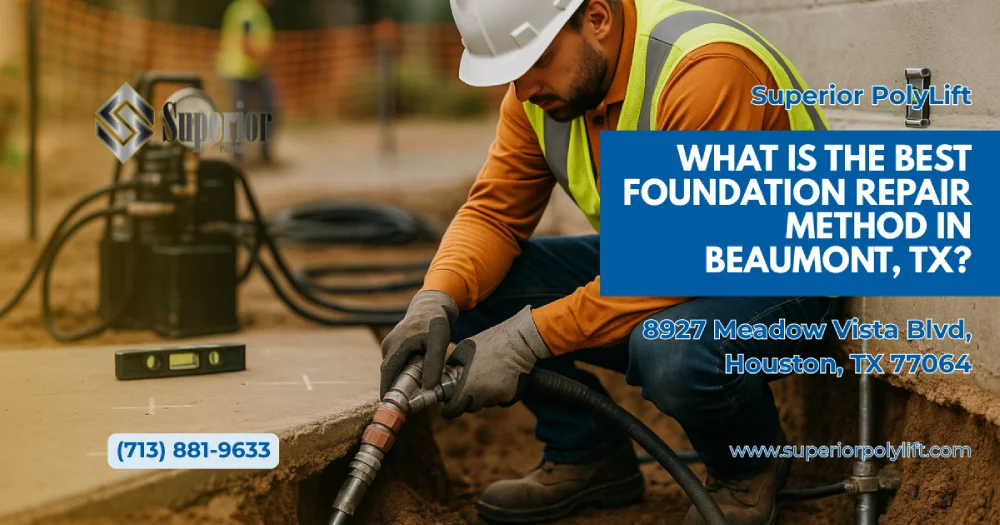
When it comes to commercial and industrial foundation repair in Beaumont, TX, few regions pose tougher challenges. High groundwater, gumbo clay, and frequent flood events can trigger severe foundation problems that jeopardize critical operations. The “best” method—whether polyurethane foam injection, steel push piers, helical piers, or drilled concrete caissons—hinges on site-specific loads, geotechnical data, and project objectives. Partnering with foundation repair specialists in Beaumont who hold Better Business Bureau (BBB) accreditation and offer nationally backed warranties ensures you receive repair solutions engineered for long-lasting performance rather than quick fixes.
Surface clays in Jefferson County can expand 5–10% after heavy rain and then contract during droughts. Over time, these cycles produce voids, cracks, and uneven floors that disrupt production lines or cause structural damage to foundation walls.
Storm surges saturate soils quickly, reduce bearing capacity, and accelerate corrosion. Any pier, pile, or caisson chosen for Beaumont must resist scour, buoyant uplift, and aggressive water chemistry—often by adding waterproof coatings or galvanization.
Distribution centers, manufacturing plants, and multistory offices impose heavier axial and lateral forces than light-duty structures. Steel push piers, helical piers, or drilled concrete caissons usually outperform foam-only systems when serious load capacity is required.
Foam injection offers attractive upfront pricing, while drilled caissons demand higher initial investment. Calculating total cost to repair over 30+ years—including inspections, maintenance, and potential shutdowns—reveals which method is genuinely worth the cost.
Many facilities operate 24/7. Polyurethane leveling and helical pier installation proceed quickly with minimal excavation, letting teams keep productivity high and preserving peace of mind for stakeholders.
| Method | Typical Depth | Install Speed | Load Capacity | Soil Suitability | Best Applications |
| Polyurethane Foam Jacking | 3–6 ft | Fast (hours) | Moderate | Near-surface voids, settled slabs | Rapid concrete leveling & crack repair |
| Steel Push Piers | 15–40 ft | Moderate | High | Soft clay over firm strata | Heavy structures needing measurable support |
| Helical Piers | 10–35 ft | Fast | High | Variable soils; low vibration sites | Sensitive facilities, tilt-wall panels |
| Drilled Concrete Caissons | 20–60 ft | Slow | Very High | Most soils, incl. corrosive | Massive loads, bulkhead repair, bridge abutments |
Technicians drill small ports and inject a two-part foam beneath the slab. The mixture expands, fills voids, and raises concrete to the desired level. Because the material weighs about two pounds per cubic foot, it adds virtually no extra stress while delivering long-lasting support. Fully cured foam resists moisture intrusion, adding supplemental waterproof benefits.
Hydraulic rams advance interlocking pier segments until they reach a stable stratum. Each pier is load-tested as it is installed, allowing real-time confirmation that engineered capacity has been achieved. Once all piers are seated, synchronized jacks bring the structure back to level and transfer weight onto competent soil layers.
Helical piers resemble giant steel screws. Crews monitor installation torque, which correlates directly with axial capacity, making quality control straightforward. Because the method produces negligible vibration, it protects precision instruments, medical devices, and critical manufacturing equipment during repair.
Large-diameter shafts are drilled, cased if necessary, reinforced, and filled with high-strength concrete. Caissons tolerate extreme compression, uplift, and lateral forces, making them indispensable for broadcasting towers, heavy industrial complexes, and waterfront bulkheads that face high wind and hydrodynamic loads.
Steel push piers and helical piers transfer loads deep below the active clay zone, virtually eliminating seasonal movement. Foam jacking reliably fills voids but still depends on near-surface soils; combining foam with piers often produces the best solutions for large structures.
Groundwater in Beaumont frequently contains chlorides that corrode unprotected steel. Hot-dip galvanizing, epoxy coatings, or stainless upgrades extend design life. Concrete caissons inherently provide a degree of corrosion resistance; however, rebar cover and mix design remain vital.
Foam injection generates minimal spoil, and the cured product is chemically inert. Helical and push pier systems displace little soil, lowering haul-off. Drilled shafts create more cuttings, so disposal planning is essential, especially following flood events.
Helical and push piers require only periodic inspection. Foam may need touch-ups if new voids develop. Caissons are largely maintenance-free when combined with proper site drainage and waterproof techniques.
Shutting down a dock or process line often costs more than structural work itself. Fast-install solutions like foam injection or helicals frequently deliver the highest ROI for mission-critical facilities.
Expect geotechnical borings, penetration tests, and moisture analysis. These results inform repair methods, pier diameter, and depth, ensuring the installation meets project loads and codes.
Engineers prepare stamped calculations that satisfy City of Beaumont and Jefferson County guidelines. Submittals typically reference International Building Code and Foundation Repair Association standards to avoid red-tag delays.
Reputable local foundation repair firms document torque, depth, and load tests, and then supply nationally backed warranties on workmanship and materials. Check BBB ratings, Google and Angi online reviews, and request a free estimate before you get started today.
Foundation repair in Beaumont demands specialized methods, materials, and expertise. Polyurethane foam injection offers rapid concrete lifting and void filling. Steel push piers and helical piers deliver deep, verifiable support, while drilled concrete caissons handle extreme loads. Working with qualified foundation support specialists who provide transparent inspection reports, detailed repair methods, and nationally backed warranties ensures the integrity of your structure for decades. Contact us today for an estimate and get matched with top foundation repair specialists committed to high-quality workmanship and long-lasting results.

Explore how our expertise can benefit your project. Reach out to our team for a consultation and discover the best solutions for your needs.
Copyright © All rights reserved. 2024 • Terms of Use and Privacy Policy • Internet Marketing by Authority Solutions®